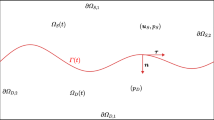Abstract
Numerical simulation of hemodynamics under the combined effects of both the host blood vessel and the microvascular network, which is based on a 2-D tumor inside and outside vascular network generated from a discrete mathematical model of tumor-induced angiogenesis, is performed systemically. And a “microvascular network—transport across microvascular network—flow in interstitium” model is developed to study the flow in solid tumor. Simulations are carried out to examine the effects of the variations of the inlet Reynolds number in the host blood vessel, the hydraulic conductivity of the microvascular wall, and interstitial hydraulic conductivity coefficient on the fluid flow in tumor microcirculation. The results are consistent with data obtained in terms of physiology. These results may provide some theoretical references and the bases for further clinical experimental research.
Similar content being viewed by others
References
NATALIE S., LARSEN I. Angiogenesis research yields new approaches to cancer treatment and prognosis [J]. J. National Cancer Institute, 1993, 85: 1629–1630.
FOLKMAN J. Tumor angiogenesis [J]. Adv. Cancer Res., 1974, 19: 331–358.
FOLKMAN J., KLAGSBRUN M. Angiogenic factors [J]. Science, 1987, 235:442–447.
JAIN R. K. Delivery of molecular and cellular medicine to solid tumors [J]. Advanced Drug Delivery Reviews, 2001, 46: 149–168.
NETTI P. A., ROBERGE S., BOUCHER Y. et al. Effect of transvascular fluid exchange on pressure-flow relationship in tumors: A proposed mechanism for tumor blood flow heterogeneity [J]. Microvascular Research, 1996, 52: 27–46.
BEARD D. A., BASSINGTHWAIGHTE J. B. Modeling advection and diffusion of oxygen in complex vascular networks [J]. Annals of Biomedical Engineering, 2001, 29: 298–310.
BAISH J. W., GAZIT Y., BERK D. A. et al. Role of tumor vascular architecture in nutrient and drug delivery: An invasion percolation-based network model [J]. Microvascular Research, 1996, 51: 327–346.
ANDERSON A. R. A., CHAPLAIN M. A. J. Continuous and discrete mathematical models of tumor-induced angiogenesis [J]. Bulletin of Mathematical Biology, 1998, 60: 857–899.
MCDOUGALL S. R. M., ANDERSON A. R. A., CHAPLAIN M. A. J. Mathematical modeling of flow through vascular network: Implication for tumor-induced angiogenesis and chemotherapy strategies [J]. Bulletin of Mathematical Biology, 2002, 64: 673–702.
STEPHANOU A., MCDOUGALL S. R., ANDERSON A. R. A. et al. Mathematical modeling of flow on 2D and 3D vascular networks: Applications to anti-angiogenic and chemotherapeutic drug strategies [J]. Mathematical and Computer Modeling, 2005, 41: 1137–1156.
GAO Hao, XU Shi-xiong, CAI Ying et al. Numerical simulation of tumor-induced angiogenesis in and out of tumor incorporating mechanical effects[J]. Journal of Medical Biomechanics, 2006, 21(3): 1–7. (in Chinese)
WU Jie, XU Shi-xiong, ZHAO Gai-** et al. 3D numerical simulation of hemodynamics in solid tumor[J]. Journal of Medical Biomechanics, 2006, 21(1): 8–13. (in Chinese)
ZHAO Gai-**, XU Shi-xiong, WU Jie et al. 2D boundary element simulations of the effect of anisotropic hydraulic conductivity coefficient on interstitial fluid flow in solid tumor[J]. Journal of Medical Biomechanics, 2006, 21(1): 14–19. (in Chinese)
KUSZYK B. S., CORL F. M., FRANANO F. N. et al. Tumor transport physiology: Implications for imaging and imaging-guided therapy [J]. American Journal of Radiology, 2001, 177: 747–753.
NETTI P. A., BAXTER L. T., BOUCHER Y. et al. Macro- and microscopic fluid transport in living tissues: Application to solid tumors [J]. AICHE Journal, 1997, 43(3): 817–834.
BAXTER L. T., JAIN R. K. Transport of fluid and macromolecules in tumors I, Role of interstitial pressure and convection [J]. Microvascular Research, 1989, 37:77–104.
BAXTER L. T., JAIN R. K. Transport of fluid and macromolecules in tumors II, Role of heterogeneous perfusion and lymphatics [J]. Microvascular Research, 1990, 40: 246–263.
XU Shi-xiong, WANG Qing-wei. Effect of heterogeneous blood perfusion on fluid flow in solid tumor [J]. Journal of Hydrodynamics, Ser. A, 2004, 19(1): 46–52. (in Chinese)
QIN Kai-rong, XU Zhe, WU Hao et al. Synergy of wall shear stress and circumferential stress in straight arteries [J]. Journal of Hydrodynamics, Ser. B, 2005, 17(6): 752–757.
Author information
Authors and Affiliations
Corresponding author
Additional information
Project supported by the National Natural Science Foundation of China (Grant No:10372026).
Biography: ZHAO Gai-**(1975-), Female, Ph. D.
Rights and permissions
About this article
Cite this article
Zhao, Gp., Wu, J., Xu, Sx. et al. Numerical Simulation of Hemodynamics in the Host Blood Vessel and Microvascular Network Generated From Tumor-Induced Angiogenesis. J Hydrodyn 18, 727–735 (2006). https://doi.org/10.1016/S1001-6058(07)60013-4
Received:
Published:
Issue Date:
DOI: https://doi.org/10.1016/S1001-6058(07)60013-4




